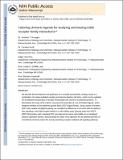| dc.contributor.author | Krueger, Andrew T. | |
| dc.contributor.author | Kroll, Carsten | |
| dc.contributor.author | Sanchez, Edgar | |
| dc.contributor.author | Imperiali, Barbara | |
| dc.contributor.author | Griffith, Linda G | |
| dc.date.accessioned | 2015-04-09T17:18:19Z | |
| dc.date.available | 2015-04-09T17:18:19Z | |
| dc.date.issued | 2014-01 | |
| dc.date.submitted | 2013-12 | |
| dc.identifier.issn | 14337851 | |
| dc.identifier.issn | 1521-3773 | |
| dc.identifier.uri | http://hdl.handle.net/1721.1/96496 | |
| dc.description.abstract | Described is the development and application of a versatile semisynthetic strategy, based on a combination of sortase-mediated coupling and tetrazine ligation chemistry, which can be exploited for the efficient incorporation of tunable functionality into chimeric recombinant proteins. To demonstrate the scope of the method, the assembly of a set of bivalent ligands, which integrate members of the epidermal growth factor (EGF) ligand family, is described. By using a series of bivalent EGFs with variable intraligand spacing, the differences in structure were correlated with the ability to bias signaling in the ErbB receptor family in a cell motility assay. Biasing away from EGFR-HER2 dimerization with a bivalent EGF was observed to reduce cell motility in an intraligand distance-dependent fashion, thus demonstrating the utility of the approach for acutely perturbing receptor-mediated cell signaling pathways. | en_US |
| dc.description.sponsorship | National Cancer Institute (U.S.). Integrative Cancer Biology Program (Grant U54-CA112967) | en_US |
| dc.description.sponsorship | National Institutes of Health (U.S.) (R01DE019523-13) | en_US |
| dc.description.sponsorship | Massachusetts Institute of Technology. Computational and Systems Biology Program. MIT-Merck Postdoctoral Fellowship | en_US |
| dc.description.sponsorship | Swiss National Science Foundation (Postdoctoral Fellowship) | en_US |
| dc.description.sponsorship | National Institute of Environmental Health Sciences (Training Grant in Environmental Toxicology 5-T32-ES007020) | en_US |
| dc.language.iso | en_US | |
| dc.publisher | Wiley Blackwell | en_US |
| dc.relation.isversionof | http://dx.doi.org/10.1002/anie.201307869 | en_US |
| dc.rights | Creative Commons Attribution-Noncommercial-Share Alike | en_US |
| dc.rights.uri | http://creativecommons.org/licenses/by-nc-sa/4.0/ | en_US |
| dc.source | PMC | en_US |
| dc.title | Tailoring Chimeric Ligands for Studying and Biasing ErbB Receptor Family Interactions | en_US |
| dc.type | Article | en_US |
| dc.identifier.citation | Krueger, Andrew T., Carsten Kroll, Edgar Sanchez, Linda G. Griffith, and Barbara Imperiali. “Tailoring Chimeric Ligands for Studying and Biasing ErbB Receptor Family Interactions.” Angewandte Chemie International Edition 53, no. 10 (January 31, 2014): 2662–2666. | en_US |
| dc.contributor.department | Massachusetts Institute of Technology. Department of Biological Engineering | en_US |
| dc.contributor.department | Massachusetts Institute of Technology. Department of Biology | en_US |
| dc.contributor.department | Massachusetts Institute of Technology. Department of Chemistry | en_US |
| dc.contributor.mitauthor | Griffith, Linda G. | en_US |
| dc.contributor.mitauthor | Imperiali, Barbara | en_US |
| dc.contributor.mitauthor | Krueger, Andrew T. | en_US |
| dc.contributor.mitauthor | Kroll, Carsten | en_US |
| dc.contributor.mitauthor | Sanchez, Edgar | en_US |
| dc.relation.journal | Angewandte Chemie International Edition | en_US |
| dc.eprint.version | Author's final manuscript | en_US |
| dc.type.uri | http://purl.org/eprint/type/JournalArticle | en_US |
| eprint.status | http://purl.org/eprint/status/PeerReviewed | en_US |
| dspace.orderedauthors | Krueger, Andrew T.; Kroll, Carsten; Sanchez, Edgar; Griffith, Linda G.; Imperiali, Barbara | en_US |
| dc.identifier.orcid | https://orcid.org/0000-0002-5749-7869 | |
| dc.identifier.orcid | https://orcid.org/0000-0002-1801-5548 | |
| mit.license | OPEN_ACCESS_POLICY | en_US |
| mit.metadata.status | Complete | |
